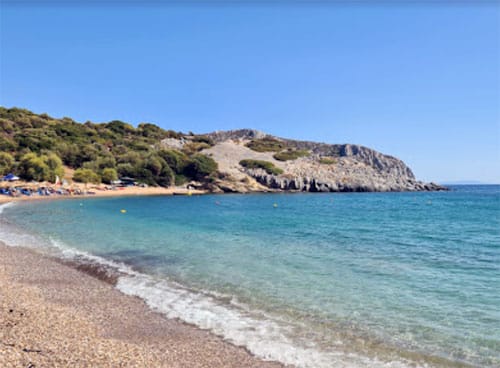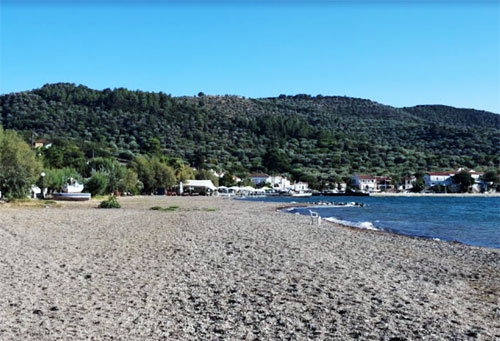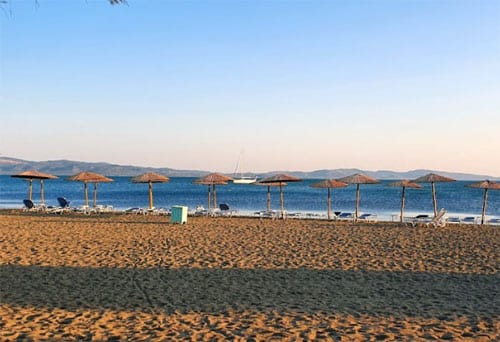What are the best beaches in Lesbos
Lesbos offers a large number and wide variety of beaches from deserted pebble coves to glorious sandy stretches awash with bars, watersports and other tourist facilities.
If you’re the sort of person who needs to visit a different beach every day of your holiday then this is the island for you.
There are beaches where you can windsurf, jet ski and down cocktails at the water’s edge. And there are quiet corners where you can safely skinny-dip in solitude without the threat of company, even in high season.
The capital Mytilini has a town beach, Tsamakia, flanking the huge walls of the Byzantine castle. You pay to get in and it’s by no means one of the island’s best beaches but it’s handy if you’re staying in town and there’s a good view of the hill top castle from the sea.
The lake-like Gulf of Yera, to the west of the town has several beaches with shallow water and wonderful views across this virtually land-locked bay.
At the south eastern corner of the island there’s the pebble beach of Haramidha which has several good tavernas. Three kilometres west along the coast there’s the more scenic, sandy double cove of Ayios Ermoyenis. The beaches here tend to get crowded, especially at weekends in July and August, because of their proximity to the capital.
The best beach on the south coast is idyllic Vatera which rates as one of the finest stretches of sand in the whole of Greece. The huge beach extends for seven kilometres and is backed by green hills and lapped by wonderfully clean and calm water, making this an ideal spot for families.
Plomari, east along the coast from Vatera, is a traditional town with pretty cobbled streets and old-style houses leading down to the fishing harbour and marina. It’s a laid-back beach resort, swarming with Scandinavian package holidaymakers in high season. This is the place to sample some of the local ouzo which is produced here and is famous throughout Greece.
Melinda, six kilometres west of Plomari, is an attractive fishing village with a 700-metre sand and shingle beach at the mouth of a canyon. To the east of Plomari lies Agios Isidoros which is ideal for snorkelling because although the beach is sandy there’s a rocky shelf beneath the crystal clear water.
The busiest and best-known beach resort on the island is Skala Eresou on the west coast which attracts a mixed bag of holiday hordes – from north European package holidaymakers and hippy types to archaeologists and lesbian groups.
The three-kilometre sandy beach here comes a close second to Vatera and offers all manner of tourist facilities including seafront tavernas with wooden dining platforms by the water.
The resort has developed over the site of ancient Eresos which was the birthplace of Sappho, one of the greatest poets of Ancient Greece. Sappho devoted her erotic poetry to her female followers, prompting speculation about her sexuality and establishing her as an idol for gay women of future generations.
Petra is the most popular beach resort on the north coast but if you’re looking for a secluded spot you can walk or take a boat excursion from Mithymna to find one of the many quiet coves which pepper this stretch of coastline.
Eftalou is within easy walking distance of Mithymna and offers a beautiful stretch of black sand and pebble beach along with the thermal baths where you can soak in healing waters of 46C.
Tsonia, 300 kilometres east of Mithymna at the north east tip of the island, is a lovely 600-metre beach of pink volcanic sand. You can reach it by boat or down a dirt track leading from Klio.
Aspropotamos beach
The road turns inland from Skala Sikaminias to the hill village of Mantmados, noted for its cheeses and fine pottery and beyond there the north-east coastal resort of Aspropotamus with its long stony beach and not much else.
Above the beach is a large village of grey stone houses that’s known maily for its 18th century church which is said to contain the ‘black icon’ of the archangel Michael, reputed to have been painted with the blood of slaughtered monks.
On the third Sunday after Easter an ox is killed and hankies dipped in its blood to draw crosses on the foreheads of the local children. Something for them to look forward to at Easter.
At the nearby hamlet of Kapi is the start of a marked hiking trail that takes in some of the finest scenery on Lesvos.

Petra beach
South of Molyvos is a string of resorts that have attracted package tour firms in recent years. First is the resort of Petra where a wide sweep of fine, grey sand is overseen by the prominent 18th century church of Panagia Glykofilousa atop sheer rock outcrop.
Petra translates as rock and a visit to the church entails climbing 120 steps from the village centre where charming old houses, many with wooden balconies, are set in narrow winding alleys.
The church on the rock may have the views but it’s another, Agios Nikolaos, that steals the show with its fine 16th century frescoes.
Tavernas abound in the winding streets and a women’s co-operative runs its own taverna offering more authentic local crafts.
Interest from package tour firms has triggered up a sprawl of tourist development along the back of the long, wide beach with the associated bars, discos and car rentals. The lack of a decent sands at Molivos also makes Petra the target of many day trippers.
Just off the road south is the sprawling mountain village of Stipsi whose huge tavernas are candidates for popular tourist ‘Greek Nights’. There is noted hill walking here too along donkey trails, with sparkling views over the sea.

Anaxos beach
West of Petra lies the holiday resort of Anaxos and a three kilometre stretch of coarse sand with a sprawling resort dubbed ‘up and coming’ in the brochures.
Despite interest from the cheaper end of the travel market, Anaxos is still a resort with character. Sunbeds clutter the smartly kept beach where sand pitches sharply into the sea.
Beach tavernas and snack bars sit nearby and Anaxos offers all the usual beach facilities and watersports.
West-facing Anaxos enjoys splendid sunsets over a trio of offshore islets and visitors report above average food in the local tavernas.
A few kilometres west is Avlaki where a tiny, sand beach boast a couple of excellent tavernas. Other coves along this stretch of coastline offer opportunities to escape the crowds.

Gavanthas beach
A track north of Antissa, poorly signposted, eventually leads to the remote fishing hamlet at Gavathas built on a peninsula.
Nearby is the long, narrow and sandy Gavathas beach which has a couple of tavernas and a few small hotels. A small harbour sits at one end of a beach backed by a few trees.
The headland shelters the main Gavathas beach with several pebble and rock coves nearby. A taverna is flanked by a couple of cafes and a small chapel rests on the rocks above. Locals often clear the seaweed which can be a nuisance along the shoreline.
Tracks lead west past wild beaches around the headland at Kambos. Lonely beaches can be found here although the going is rough and so are the seas when the north wind gets up.

Beaches on the south coast of Lesbos
The south-east is dominated by the mountain of Profitis Ilias and flanked east and west by the gulfs of Kallonis and Geras. Olive groves and pine forest dominate and this is one of the most beautiful parts of Lesvos, with pretty villages flung around the rolling hillsides. The Bay of Yeras is almost an inland sea and it has some of the most important wetlands of Greece.
Therma beach
Further north from Mytilini are the iron-rich thermal springs at Therma. The ancient public baths are closed to the public but behind is a new public bath house.
A Turkish tower standing next to Therma baths is impressive and there are restaurants and a small beach near the harbour. Also worth a visit is the nearby monastery of Agios Raphael.
There are sands near Mistegna and Neas Kidonioa but they are not particularly attractive. Mistegna village is a maze of alleyways and has some interesting ceramic shops.

Agios Ermogenis beach
The Gulf of Gera has little to offer the beach visitor and it is several kilometres south of the Gulf before a beach of any note in the small sheltered bay at Tarti.
Hardly touched by package tourism, Tarti beach is a big favourite of the locals. Set in a pretty bay, the beach of coarse sand and pebble has sunbeds and tavernas.

Tarti beach
The Gulf of Gera has little to offer the beach visitor and it is several kilometres south of the Gulf before a beach of any note in the small sheltered bay at Tarti.
Hardly touched by package tourism, Tarti beach is a big favourite of the locals. Set in a pretty bay, the beach of coarse sand and pebble has sunbeds and tavernas.
Tarti is a popular spot for rough (but illegal) camping and boats often tie up to the small quay as the beach is easier to reach by boat than it is overland.
Road access to Tarti beach is along a rough track that drops down from the main road, and tricky enough to deter all but the most adventurous. The underwater caves off the nearby islet of Fara are a popular target of scuba divers.
Tarti is a popular spot for rough (but illegal) camping and boats often tie up to the small quay as the beach is easier to reach by boat than it is overland.
Road access to Tarti beach is along a rough track that drops down from the main road, and tricky enough to deter all but the most adventurous. The underwater caves off the nearby islet of Fara are a popular target of scuba divers

Vatera beach
The longest beach on Lesvos lies west of Plomari at Vatera, a huge and magnificent bank of sand and shingle beach by wooded hills and about 50 kilometres from Mytilini.
The length depends on which guide is referenced but it is anything from six to 20 kilometres, much of it untouched and ideal for any seeking wild solitude. Several good walking trails can be found east of Vatera on paths well-marked with yellow circles.
There is no settlement at Vatera, just beach hotels. The nearest village is four kilometres inland at Vrissa, where walls remain of an ancient Trojan town destroyed in 1180 BC. Vrissa has a good museum with a mastodon fossil and various other treasures.
At the west end of Vatera beach a clutch of hotels and restaurants line the shore with views to the cape at Agios Fokas and the ruins of a temple to Dionysos beneath a Christian basilica.
The chapel of Agios Fokas marks the spot where an ancient port lay and paved slabs can still be seen under the water. Today, it is a small fishing port with coffee house and some fish tavernas.

Polichnitos beach
The western shore of Kallonis Bay is weed infested and much of it inaccessible so there is little here to interest the visitor.
The small resort at Skala Polichnitos is noted for its many tavernas and its salt pans which stay wet even in high summer and can attract as many birdwatchers as birds.
Inland among the pines is Polichnitos, a dreary village of decaying mansion houses, although its domed and recently restored thermal baths boast the hottest waters in Europe (91°C).
There are three mineral springs in use near Polichnitos. The main bathhouse is close to the river bank above the seashore and has two pools (male and female).
There is another spa at nearby Lisvori where the water is red stained with iron. One of the lesser visited hot springs it is set in lovely countryside and has a small and excellent, taverna.

Beaches on the west coast of Lesbos
The western half of Lesvos is much less developed than the north and east and dominated by impressive mountains with the coastal areas backed by large, fertile plains and gentle roiling hills. The only two beach resorts of note are Skala Kaloni in the Kaloni Gulf and Skala Eressos in the south-east. To the far west is the world’s second largest petrified forest of Sequoia trees.
Skala Kalloni beach
On the Gulf coast, about three kilometres south of Kalloni, is the beach resort of Skala Kalloni, now a major package resort thanks to a long beach of coarse sand backed by tamarisk trees.
Tavernas, apartments and small cater to the tourist influx and the resort can feel overcrowded and busy, especially in the high season.
The sands are long and deep and the waters generally calm and shallow, making it an ideal place for children.
Sardines from the sheltered Gulf are prized throughout Greece and tavernas in the harbour serve up the freshest catch of the day.
The Skala Kaloni Sardine Festival in August centres on the village square and free ouzo and sardines accompany the music and dancing. There is no shortage of tavernas, both in the harbour and along the beach, with several shops and a bakery.
The resort’s other attraction is birds. Thousands descend on the salt pans, reed beds and other wetland spots for the spring nesting while flamingos flock to the shallow waters edging the Gulf.

Eressos beach
The main resort in the west of Lesvos is Skala Eressos, a magnet for lesbians thanks to the ancient Greek lyric poet Sappho, who penned her verses and ran a school for girls here around 580BC.
The locals are relaxed about the connection and these days Skala Eressos is as popular with typical families and a firm favourite of honeymooning couples. The reasons are pretty obvious.
A long, sandy and beautiful beach lines the shore with tamarisk shaded tavernas fringing the sands, many built on bamboo decking sands and specialising in fish dishes – the Gulf being famed throughout Greece for its sardines.
Behind the beach, the village is modern but well laid out with car-free streets and a cheerful charm with an attractive central square.
A small harbour with its own sheltered beach sits nearby while a spring-fed lake is full of wildlife including storks and tame turtles that take food by hand, always with the risk of an occasional nip.
Skala Eressos is a major centre for bird watching and the flat plains are ideal for biking or horse riding. Several beaches lie to the east.
Chrousos has a fine crescent of golden sand at the mouth of the Mallonta river while the sand and shingle at Tavari is shaded by tamarisks and has beach tavernas and a dinky harbour.
Further east, the hamlet of Podaras has a deep swathe of sand at the end of a fertile river valley carpeted in olive and citrus groves.

Sigri beach
On the far west coast of Lesvos, the remote seaside village of Sigri is approached down a long road over the broad coastal plain.
A quiet fishing harbour is overlooked by a small Turkish fortress, built in 1757, and a narrow sheltered crescent of sand and pebble shelves gently into the sea.
The offshore islet of Nissopi provides sheltered anchorage for NATO warships and restricted access to some parts of this coast.
Sigri village centre is modern and dull but the harbour, though tarted up for tourists, has a traditional feel despite a fake ‘Cycladic’ windmill.
Sigri is so quiet that some liken it to a ghost village but the end-of-the-world feel suits those looking for a relaxed holiday.
The world-famous petrified forest has a new visitor centre just outside Sigri village and some of the best specimens of petrified tree trunk lie on a path to the south, well marked with yellow triangles.
Sigri beach is hemmed in by the road but the sand is good, the waters shallow and offshore breezes keep sunbathers cool. Isolated coves lie north with Faneromeni probably the best – a lovely arc of sand at the mouth of a river.
The best beach to the south is at Tsichlioda where tall grasses spring up at the end of a long valley – a haven for migrating birds.

